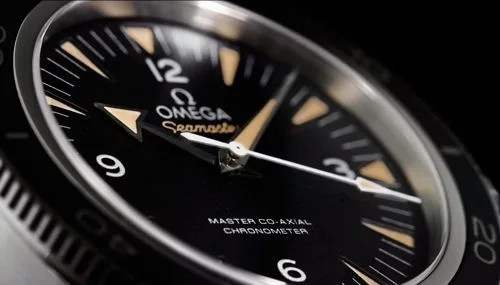Today’s dive watches, as numerous and shiny as a school of mackerel, can all trace their heritage back to the pioneering timepieces of the 1950s and ‘60s. Scuba diving was in the full flush of popularity then; Sea Hunt and Captain Cousteau were on TV and 007 was fending off evil frogmen underwater. The dive watch was not only a necessary instrument for underwater maneuvers but a symbol of adventure and rugged readiness topside. OMEGA introduced its first diving watch, the Seamaster 300, in 1957 as part of its “Master” triumvirate along with the Speedmaster and the Railmaster. All three watches used the same 39-millimeter case, but diverged in form and function. That first Seamaster 300 sported a rotating bezel with a narrow acrylic insert, a “broad arrow” handset and 200 meters of water resistance, which OMEGA says was the limit of testing equipment at the time. The watch straddled utility and style better than many other dive watches of the era and remains a desirable collector’s piece.
At BaselWorld 2014, OMEGA released a watch with the Seamaster 300 name for the first time in over 40 years, the Seamaster 300 Master Co-Axial. The watch has a pitch-perfect blend of vintage styling and modern watchmaking technology that drew almost unanimous acclaim. There’s the narrow bezel resembling the 1957 original, but now uni-directional and ratcheting, crafted from scratch-proof LiquidMetal instead of fragile acrylic. The straight-lugged case without crown guards is also present, but now increased to 41 millimeters to better suit modern tastes. The dial is a textured matte black with the familiar Seamaster script and triangular markers, which are done in a perfect faded yellow, as if the watch had been aging in a dive locker for 60 years, ridden hard and put away wet. It also lacks a date function, which hews to its ancestor’s original brief. While all that retro is enough to make a dive watch fan swoon, you’ve got to go deeper inside to truly appreciate why this watch is so special.
The “Master Co-Axial” part of the name refers to OMEGA’s calibre 8400, a twin-barrel self-winding movement with a co-axial escapement that defies the effects of friction better than conventional lever escapements. The movement, while utilitarian, is lovely to look at, with radially patterned bridges and a winding rotor that seem to magnify the movement. OMEGA chose to use a display case back on this homage to a classic in order to show off the calibre 8400’s pièce de résistance: the anti-magnetic technologies that render it impervious to magnetic influences. Proprietary alloys and a prodigious use of silicon resist the stereo speakers, limpet mines and shipwrecks that can wreak havoc on a watch’s accuracy. With no need for a soft iron movement holder, the movement can be admired in all its state-of-the-art glory while staying resistant to magnetism up to a CERN-worthy 15,000 Gauss.

On its own, a beautiful vintage-styled watch might make the short list for the GP100. But OMEGA’s tasteful rendering of a 1950s watch, with perhaps its best movement inside, moves the Seamaster 300 Master Co-Axial right to the top. It is a modern classic and a watch that diehard OMEGA fans have hoped the brand would bring back for years.
